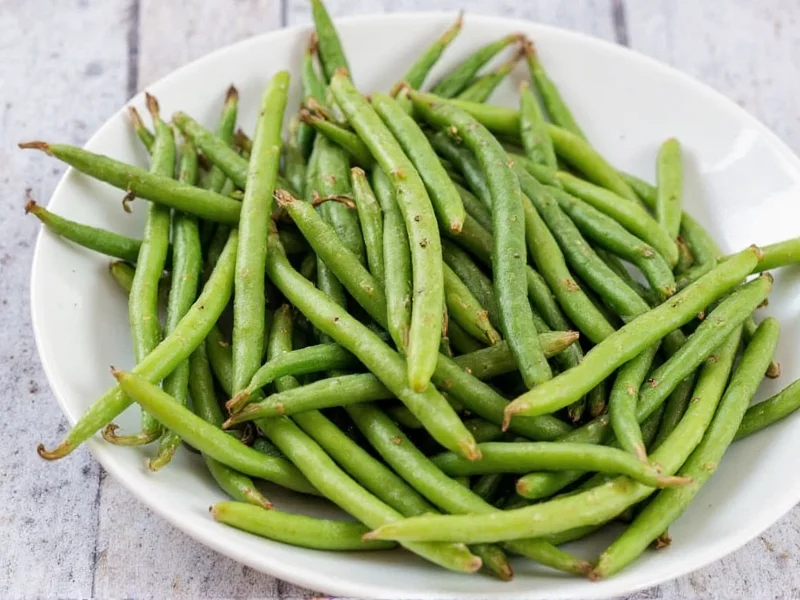Green beans often get overlooked as a bland side dish, but with the right seasoning approach, they transform into a standout component of any meal. The secret lies in understanding how green beans' delicate flavor profile interacts with different seasonings. Unlike heartier vegetables, green beans require balanced seasoning that complements rather than overwhelms their subtle earthiness.
Top 5 Seasoning Combinations for Green Beans
Professional chefs consistently reach for these proven combinations that highlight green beans' natural qualities while adding complexity. Each option works with specific cooking methods for optimal results.
| Seasoning Combination | Best Cooking Method | Recommended Quantity (per lb beans) | Flavor Profile |
|---|---|---|---|
| Garlic-Herb Blend | Sautéing | 2 minced garlic cloves, 1 tsp thyme, 1 tbsp olive oil | Earthy with aromatic notes |
| Lemon-Almond | Roasting | 1 tbsp lemon zest, 2 tbsp toasted slivered almonds | Bright and nutty |
| Bacon-Parmesan | Steaming then finishing | 2 tbsp crispy bacon, 2 tbsp grated parmesan | Savory umami boost |
| Asian-Inspired | Stir-frying | 1 tbsp sesame oil, 1 tsp ginger, 1 tbsp soy sauce | Sweet-savory complexity |
| Mediterranean | Grilling | 1 tbsp oregano, 1 lemon (juiced), 2 tbsp feta | Herbaceous and tangy |
The Science Behind Flavor Pairing with Green Beans
Understanding why certain seasonings work better than others with green beans comes down to basic flavor chemistry. Green beans contain natural sugars and amino acids that react differently to various cooking techniques. When you sauté green beans, the Maillard reaction creates new flavor compounds that pair exceptionally well with garlic and onions.
Fat-soluble seasonings like garlic and herbs release their full flavor when cooked in oil, while water-soluble ingredients like lemon juice work best added at the end of cooking. This explains why finishing green beans with a squeeze of fresh lemon after cooking preserves the bright acidity that complements their earthiness.
How Cooking Methods Affect Seasoning Success
The technique you use to prepare green beans dramatically impacts how seasonings interact with them. Each method requires different seasoning timing and ingredient selection for optimal results:
- Steaming: Add delicate seasonings like fresh herbs and lemon zest after cooking, as steam leaches water-soluble flavors
- Sautéing: Introduce aromatics like garlic and onions early to infuse the oil, then add beans to absorb those flavors
- Roasting: Toss beans with oil and dry seasonings before cooking to allow caramelization and flavor penetration
- Blanching: Shock in ice water after cooking, then finish with vinaigrette-based dressings for maximum flavor adherence
Dietary-Specific Seasoning Solutions
Whether you follow specific dietary restrictions or preferences, excellent green bean seasoning options exist for every eating style:
Vegan cooks achieve remarkable depth using smoked paprika and nutritional yeast instead of bacon. For low-sodium diets, lemon zest, garlic powder, and fresh herbs provide big flavor without salt. Those following keto diets can enhance green beans with bacon fat and toasted pecans for satisfying richness.
Gluten-free cooks should watch soy sauce in Asian-inspired recipes—opt for tamari instead. Diabetics benefit from the natural sweetness of roasted green beans paired with balsamic vinegar reduction, which has a lower glycemic impact than sugar-based glazes.
Avoiding Common Green Bean Seasoning Mistakes
Many home cooks make these preventable errors that diminish green beans' potential:
- Adding salt too early in boiling, which can make beans mushy
- Overpowering delicate green beans with strong spices like cumin or chili powder
- Using dried herbs instead of fresh for finishing touches
- Not tasting before serving—seasoning needs vary based on bean freshness
- Applying acidic ingredients too early in cooking, which prevents proper softening
Professional chefs recommend seasoning in layers: a small amount during cooking and the majority in the final minute. This technique ensures balanced flavor throughout without any single element dominating.
Advanced Flavor Combinations for Culinary Enthusiasts
For those ready to elevate their green bean game, consider these sophisticated pairings that showcase seasonal ingredients and global influences:
During spring, pair young green beans with morel mushrooms and tarragon for an elegant French-inspired dish. Summer calls for cherry tomatoes and basil with a light white wine reduction. Fall works beautifully with toasted walnuts and apple cider vinegar. Winter green beans shine with orange zest and toasted hazelnuts.
International variations offer exciting possibilities: try Indonesian-style with kecap manis and shallots, or Mexican-inspired with epazote and lime. Japanese chefs often use bonito flakes for umami depth in green bean dishes, while Italian preparations feature anchovy paste melted into the cooking oil.











 浙公网安备
33010002000092号
浙公网安备
33010002000092号 浙B2-20120091-4
浙B2-20120091-4